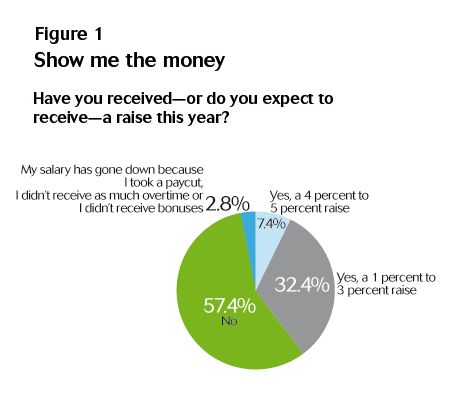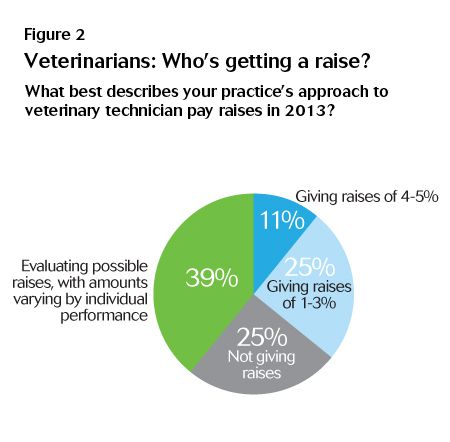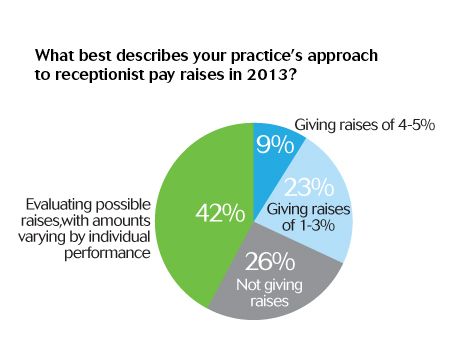Payday too far away at your veterinary practice?
Survey answers show many of you are feeling squeezed by the economy. Here's help.
Next >
Many team members report they won't get raises this year. And in many cases, it's not because your practice owner doesnÕt want to give you one, says Firstline Editorial Advisory Board member Kyle Palmer, CVT, a practice manager at Silver Creek Animal Clinic in Silverton, Ore.
Firstline board member Pam Weakley, a practice manager at Dickman Road Veterinary Clinic in Battle Creek, Mich., says practice owners may be caught in the middle, between the struggle to keep pet care affordable for clients and the rising cost of supplies, fuel surcharges for deliveries and overhead--including rent and utilities. "If clients stop walking through the door, there's no business," Weakley says. Figure 1 shows that fewer than half of team members expect to get a raise this year. But data from the Veterinary Economics Business Issues Survey shows that between 65 percent and 75 percent of veterinarians are at least considering raises this year--a welcome break for some practices that have suffered pay freezes since 2009.

If you're feeling frustrated, you're not alone. But take heart. Our board members say you can move closer to achieving your raise with these steps:
Step 1: Encourage your practice owner to open the books
"Practice owners and managers should be open and up front about the challenges we face during these times to make employees part of the team in every way," Palmer says. As a team member, understanding your practice's financial situation will help you work toward your practice's common goals. (See "Sample script: Asking your owner to open the books" for advice on how to talk about the practice's finances with your boss.) Firstline board member Marianne Mallonee, CVPM, hospital administrator and part owner of Wheat Ridge Animal Hospital in Wheat Ridge, Colo, says owners and managers don't need to put an exact dollar number on everything for every team member in the practice. The key is to talk to the entire staff about the revenue and expenses that influence the practice's profitability. An easy place to start is by sharing revenue and number of office visits, Mallonee says. And if it's uncomfortable, you don't need to share the dollar amounts. Use a graphic form to show how percentages have changed from 2008 to present to give team members an idea of the practice's fiscal health.

Step 2: Help build a better business
Mallonee says from a business perspective her practice is busier than it has been in several years. Mallonee's practice offers a quarterly bonus system if the practice meets key financial goals. For the last several years, the targets seemed out of reach, but in the last six months Mallonee says they're seeing numbers that make bonuses possible.
If you're working for a veterinary practice and you've noticed business is improving, you might start to wonder where the raises are. Be patient, Mallonee says. "I absolutely understand employees being very frustrated with this type of situation," Mallonee says. "From an employer's perspective, I think many team members don't know how much we protected our employees from the truth of our economic situation over the last four to five years. My guess is, many practice owners are playing catch-up financially and they're being more conservative to be prepared for the next challenge." (See "5 reasons you haven't gotten your raise yet.")

Step 3: Your attitude makes a difference
One way to channel your frustration is to focus on what you can control. For example, Mallonee says she urges team members to focus on the basics: getting clients in the door, providing a superb level of client communication and locking in compliance on wellness recommendations. If you hear your solo-doctor's business is a $1 million practice, you might assume that your veterinarian is pocketing $1 million in profits, but that's just not so. Out of that money, your doctor pays the staff, for the building and the equipment and the inventory and everything else that goes along with running a business. "And I know there are veterinary practices out there where the practice revenue dropped below what they need to just break even on a yearly basis. And that's pretty powerful for team members to see this is why I'm not getting a raise right now, Dr. Smith is playing catch-up from three years ago," Mallonee says. "Ultimately, when these veterinary practices do choose to give out raises, you want to be seen as the employee who's coming to work with a smile still on your face. You want to be viewed as that standout. The one who was positive and working hard to make the practice client-centric. And when raises are due, you're going to be the first team member who comes to mind."
